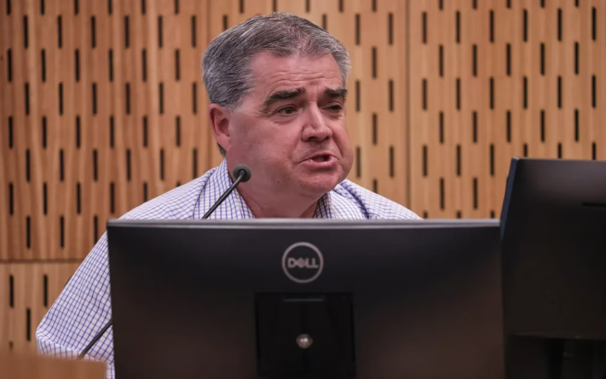
By Danielle Clent of RNZ
A senior police communicator has admitted that a call containing vital information about the Christchurch terrorist’s plans should have been treated with the highest priority and shared widely among the police.
The inquest into the attacks on the Al Noor Mosque and the Linwood Islamic Centre on March 15 2019, during which 51 worshippers were murdered, last week heard the information was missed by dispatchers and senior officers due to its “Priority 2″ status.
Bret Watkins, team leader in the Police Southern Communications Centre at the time of the attack, gave evidence on Monday as the inquest entered its second week.
/cloudfront-ap-southeast-2.images.arcpublishing.com/nzme/5EWJBXVDQZAQVO6FQKXPZMI5PU.png)
Senior police communicator Bret Watkins. Photo / Chris Skelton
He ultimately agreed the first 111 call, which came from Parliamentary Services about the terrorist’s manifesto, should have been upgraded to a “Priority 1″ call.
The call-taker and her supervising mentor last week told the inquest they believed the parliamentary staffer’s call was appropriately labelled a national security event and given the “Priority 2″ coding.
The sheer volume of “Priority 1″ firearms events that came into the centre following that call flooded the system and the staffer’s call was never acted on.
In his evidence, Watkins told the court that the first event he was aware of in relation to the attack on March 15 was a firearms offence, and he quickly realised it was an active shooter situation.
While dealing with that and co-ordinating the response, Watkins said the call-taker’s supervisor approached him and told him about the parliamentary staffer’s call.
- Dispatcher not aware of first 111 call about manifesto until days later, terror attack inquest finds
- March 15 inquest: 111 call made minutes after gunman's manifesto sent to PM
- ‘Could they have been saved?’ - Inquest into Christchurch terror attack begins as families ask for answers
He recalled the supervisor telling him there was going to be a shooting at a mosque - to which he replied: “It’s already happening.”
Watkins said he could not recall the mentor ever mentioning a Linwood mosque or an Ashburton mosque as being targets.
He asked her to get the email sent to him.
Watkins then quickly scanned it and forwarded it to another police staff member to search through. That was the last action he took in relation to it that day.
/cloudfront-ap-southeast-2.images.arcpublishing.com/nzme/A7JBU4URTRCW7HGYYRX6S5BOBY.jpg)
David Boldt, counsel assisting the coroner, pictured during the inquest into the March 15 terror attack in the District Court at Christchurch. Photo / George Heard
Under cross-examination by David Boldt, the counsel assisting the coroner, Watkins said he should have acted on the parliamentary staffer’s call after the supervisor told him about it and upgraded it to a “Priority 1″ call.
That way, the staff he had tasked to read through all event chronologies to find any important information would have seen the entries the call-taker had put in, including “Linwood mosque is potential danger”.
He agreed that information was vital and, as Boldt put it, should have been “shouted from the rooftops”.
Watkins admitted: “Due to the number of P1 events we were reading, that information was overlooked.”
Earlier evidence from police dispatcher Dara Taylor showed that only one message on the police Intercad system was sent through to St John Ambulance, as it was more efficient to physically run messages between police and St John communications staff, as they worked from the same location.
/cloudfront-ap-southeast-2.images.arcpublishing.com/nzme/HETI3HUMNZHTXPEH72ICHEFLGQ.png)
Police constable Dara Taylor. Photo / Iain McGregor
There had been “frustration” about the systems not working well with each other and it was believed funding was needed so St John could be upgraded to a better system, Taylor told the inquest.
Watkins said some upgrades had happened since, and the police and St John systems do now work better, but he still had recommendations of his own.
The computer system the communications centre used was nearly 30 years old, at the end of its life, and due for replacement, he said.
Watkins said being able to see multiple events at the same time on the screen - in real-time - would help staff see event updates quicker
Overseas jurisdictions used AI (artificial intelligence) to assist communicators and it could also be useful in New Zealand, he said.
It could help assess risk and what priority 111 calls should receive.
The inquest will examine the following 10 issues over six weeks:
- The events of March 15 2019 from the commencement of the attack until the terrorist’s formal interview by police
- The response times and entry processes of police and ambulance officers at each mosque
- The triage and medical response at each mosque
- The steps that were taken to apprehend the offender
- The role of, and processes undertaken by, Christchurch Hospital in responding to the attack
- Co-ordination between emergency services and first responders
- Whether the terrorist had any direct assistance from any other person on 15 March 2019
- If raised by immediate family, and to the extent it can be ascertained, the final movements and time of death for each of the deceased
- The cause of death for each of the victims and whether any deaths could have been avoided
- Whether Al Noor Mosque emergency exit door in the south-east corner of the main prayer room failed to function during the attack and, if so, why?
The inquest continues.
- RNZ
Take your Radio, Podcasts and Music with you









